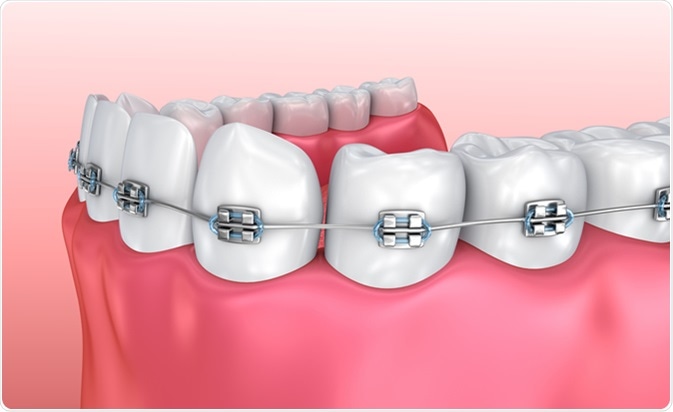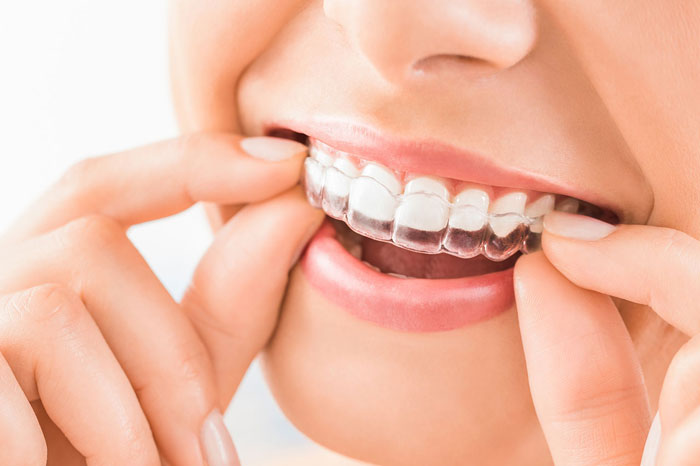Why Orthodontic Treatment ?
Nothing is more important as a genuine heartfelt smile. Whether in your professional life or when socialising, an attractive smile can make you feel happier and more confident, as well as make the right impression.
Orthodontics is a dental speciality concerned with the diagnosis, prevention and treatment of facial and dental irregularities such as crooked, crowded or protruding teeth. Orthodontic treatment is specifically designed and planned with your needs in mind by our Specialist Orthodontist or braces expert. Therefore, if you've ever thought about improving your smile, no matter what age, orthodontics may be for you.

We at Solanki Dental Center provide different types of brackets; ceramic, self ligating, metal brackets and aligners to our patients depending on their needs and requirements. End treatment results obtained from all the systems are same.
Ceramics brackets : blends with the teeth which makes it's unnoticeable.
Metal brackets : are the most common brackets used in the field of orthodontics and are cost effective
Self ligating brackets : Fewer appointments needed to apply braces or to make adjustments. Increased comfort because of low-profile brackets and no ties. Efficient tooth movement for shorter treatment time.
Aligners : One of the benefits of wearing the aligners is that it allows patients to remove them to consume food without limitations. With traditional braces, certain foods can become entangled within the wire structure and make them difficult to clean.
We provide Invisalign: The Invisalign System is a virtually invisible treatment that uses an innovative approach to effectively straighten teeth. Invisalign treatment uses a series of custom-made removable aligners with unique SmartForce technology that gradually moves your teeth to the deal position.
The benefits of orthodontic treatment include a healthier mouth, a more pleasing appearance, and teeth that are more likely to last a lifetime.
A specialist in this field is called an orthodontist. Orthodontists receive two or more years of education beyond their four years in dental school in an ADA-approved orthodontic training program.
How do I Know if I Need Orthodontics ?
Only your dentist or orthodontist can determine whether you can benefit from orthodontics. Based on diagnostic tools that include a full medical and dental health history, a clinical exam, plaster models of your teeth, and special X-rays and photographs, an orthodontist or dentist can decide whether orthodontics are recommended, and develop a treatment plan that's right for you.

If you have any of the following, you may be a candidate for orthodontic treatment:
Overbite : sometimes called "buck teeth" where the upper front teeth lie too far forward (stick out) over the lower teeth.
Underbite : a "bulldog" appearance where the lower teeth are too far forward or the upper teeth too far back.
Crossbite : when the upper teeth do not come down slightly in front of the lower teeth when biting together normally.
Open bite : space between the biting surfaces of the front and/or side teeth when the back teeth bite together.
Misplaced midline : when the center of your upper front teeth does not line up with the center of your lower front teeth.
Spacing : gaps, or spaces, between the teeth as a result of missing teeth or teeth that do not "fill up" the mouth.
Crowding : when there are too many teeth for the dental ridge to accommodate.
How Does Orthodontic Treatment Work ?
Many different types of appliances, both fixed and removable, are used to help move teeth, retrain muscles and affect the growth of the jaws. These appliances work by placing gentle pressure on the teeth and jaws. The severity of your problem will determine which orthodontic approach is likely to be the most effective.
Fixed appliances include:
Braces : the most common fixed appliances, braces consist of bands, wires and/or brackets. Bands are fixed around the teeth or tooth and used as anchors for the appliance, while brackets are most often bonded to the front of the tooth. Arch wires are passed through the brackets and attached to the bands. Tightening the arch wire puts tension on the teeth, gradually moving them to their proper position. Braces are usually adjusted monthly to bring about the desired results, which may be achieved within a few months to a few years. Today's braces are smaller, lighter and show far less metal than in the past. They come in bright colors for kids as well as clear styles preferred by many adults. Special fixed appliances used to control thumb sucking or tongue thrusting, these appliances are attached to the teeth by bands. Because they are very uncomfortable during meals, they should be used only as a last resort.
Removable appliances include:
Aligners : an alternative to traditional braces for adults, serial aligners are being used by an increasing number of orthodontists to move teeth in the same way that fixed appliances work, only without metal wires and brackets. Aligners are virtually invisible and are removed for eating, brushing and flossing. Removable space maintainers : these devices serve the same function as fixed space maintainers. They're made with an acrylic base that fits over the jaw, and have plastic or wire branches between specific teeth to keep the space between them open.
